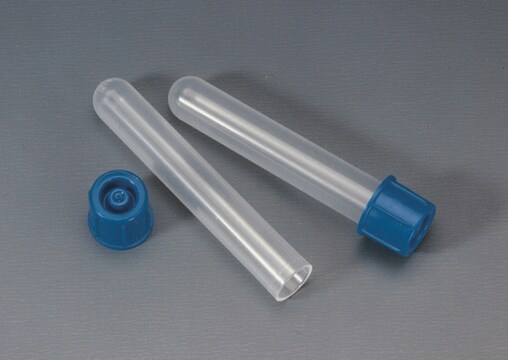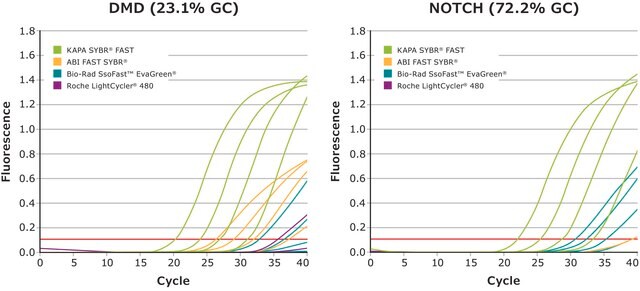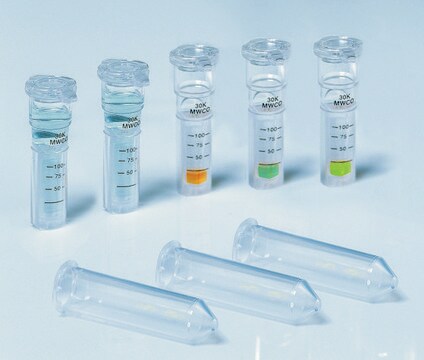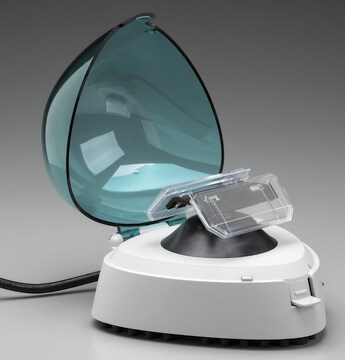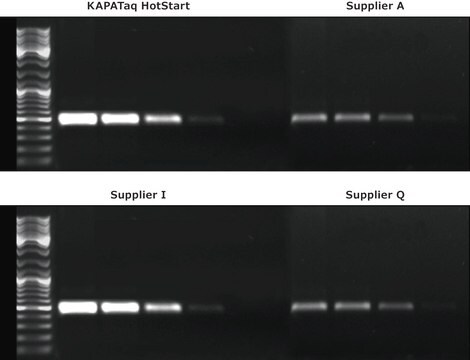SFUKB
Roche
KAPA SYBR® FAST
suitable for qPCR, 2 ×, Universal
Synonym(s):
SYBR, qPCR
About This Item
Recommended Products
Quality Level
usage
sufficient for 100 reactions
sufficient for 1000 reactions
sufficient for 500 reactions
sufficient for 5000 reactions
shelf life
≤12 mo.
feature
dNTPs included
hotstart
packaging
kit of 1 mL (100 x 20 μL rxn; KK4600)
kit of 10 mL (1000 x 20 μL rxn; KK4602)
kit of 5 mL (500 x 20 μL rxn; KK4601)
kit of 50 mL (5000 x 20 μL rxn; KK4618)
manufacturer/tradename
Roche
concentration
2 ×
technique(s)
qPCR: suitable
input
purified DNA
compatibility
for use with Agilent Mx3000P
for use with Agilent Mx3005P
for use with Agilent Mx4000
for use with Applied Biosystems® 5700
for use with Applied Biosystems® 7000
for use with Applied Biosystems® 7300
for use with Applied Biosystems® 7500
for use with Applied Biosystems® 7700
for use with Applied Biosystems® 7900HT
for use with Applied Biosystems® ViiA 7
for use with QuantStudio™
for use with StepOne™
for use with StepOnePlus™
detection method
SYBR® Green
storage temp.
−20°C
Looking for similar products? Visit Product Comparison Guide
General description
The improved robustness, processivity, and speed of KAPA SYBR FAST qPCR Kits result in consistently high amplification efficiencies enabling more accurate relative quantification for gene expression analysis. KAPA SYBR FAST qPCR Kits, developed to perform optimally in stringent real-time PCR reaction conditions, exhibit dramatic improvements to signal-to-noise ratio (fluorescence), quantification cycle (Cq), linearity, and sensitivity.
Application
- Gene expression
- Gene knockdown validation
- Microarray validation
- ChIP analysis
- Low copy detection
- Absolute quantification of NGS libraries
- Quantitative real-time PCR
Features and Benefits
- High reaction efficiency between 95 - 105% improves accuracy and reproducibility.
- Unbiased efficiency across a wide range of GC contents and amplicon lengths.
Detect low copy and difficult targets consistently
- Improved processivity results in earlier Cq scores.
- Higher fluorescence detection across varying AT- and GC-rich targets.
- Novel enzyme is resistant to SYBR® inhibition.
Complete real-time PCR runs in just 40 minutes
- 55% shorter run times with fast cycling protocol.
- Maintain high performance when switching from standard to fast protocols.
Quick Notes:
- This kit contains an engineered enzyme optimized for qPCR using SYBR Green I dye chemistry.
- The 2X master mix contains a proprietary buffer. Together with the novel enzyme, this improves amplification efficiency of both GC- and AT-rich targets.
- 20 sec initial denaturation at 95°C is sufficient for enzyme activation. When working with complex templates, an initial denaturation of 3 min is recommended.
- For 3-step cycling, use 20 sec for primer annealing and 1 sec for extension/data acquisition at 72°C.
- Do not exceed 25 μL reaction volumes.
Quality
Preparation Note
The SYBR Green I dye contained in KAPA SYBR FAST qPCR Master Mix (2X) and ROX/fluorescein dyes (depending on kit configuration) are light sensitive. Exposure to direct light for an extended period of time will result in loss of fluorescent signal intensity.
KAPA SYBR FAST qPCR Master Mix (2X) is stable through 30 freeze-thaw cycles. Ensure that all reagents are stored protected from light at -20°C when not in use. When protected from light, reagents are stable in the dark at 4°C for at least one week and may be stored at this temperature for short-term use, provided that they do not become contaminated with microbes and/or nucleases.
Other Notes
Legal Information
Kit Components Only
- KAPA SYBR® FAST DNA Polymerase
- Reaction buffer
- dNTPs
- SYBR® Green I dye
- MgCl2 2.5 mM
- ROX™ High Reference Dye (50X)
- ROX™ Low Reference Dye (50X)
- Stabilizers
Signal Word
Warning
Hazard Statements
Precautionary Statements
Hazard Classifications
STOT SE 2
Storage Class Code
12 - Non Combustible Liquids
WGK
WGK 1
Flash Point(F)
does not flash
Flash Point(C)
does not flash
Certificates of Analysis (COA)
Search for Certificates of Analysis (COA) by entering the products Lot/Batch Number. Lot and Batch Numbers can be found on a product’s label following the words ‘Lot’ or ‘Batch’.
Already Own This Product?
Find documentation for the products that you have recently purchased in the Document Library.
Customers Also Viewed
Articles
An overview of directed evolution and the methods for generating proteins with optimized or entirely new functions.
Our team of scientists has experience in all areas of research including Life Science, Material Science, Chemical Synthesis, Chromatography, Analytical and many others.
Contact Technical Service
